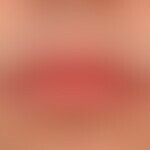DefinitionThis section has been translated automatically.
Pharmacodynamics (Effect)This section has been translated automatically.
You might also be interested in
IndicationThis section has been translated automatically.
- Topical: in acne papulopustulosa.
- Systemic: most severe forms of acne papulopustulosa, acne conglobata, acne tetrade. In rosacea, the use of low-dose therapy should be considered.
Dosage and method of useThis section has been translated automatically.
Initially 0.5 mg/kg bw/day p.o. for 4 weeks, then with good results the same dose for 2-3 months. If the effect is insufficient, increase the dose up to 1 mg/kg bw/day. Dosages of more than 40 mg/day should be divided into two single doses. If the initial dose is low, the success of the therapy takes longer. With extensive clinical improvement gradually (0.1 mg/kg bw every 4 weeks) reduction to a maintenance dose (0.05-0.1 mg/kg bw/day). For the maintenance dose of 0.05 mg/kg bw/day good healing rates are documented. Here, the NW profile is clearly reduced.
The recommended duration of therapy is 15-20 weeks. Experience has shown that in some patients only longer treatment periods, up to 32 weeks, guarantee complete healing. The total dose should be above 120 mg/kg bw.
As a "low-dose" application, good experience with rosacea has been reported (initial: 10 mg/day p.o.; maintenance dose 10 mg every 2nd day).
Standard concentrationThis section has been translated automatically.
Undesirable effectsThis section has been translated automatically.
Topical: Erythema, lightening of skin and hair, skin irritation, skin dehydration, skin flaking, skin atrophy, photosensitization, pruritus, rhagades. Rare hyperhidrosis.
Systemic: see the general side effects of retinoids; see under retinoids.
The most frequent side effects are dryness of the lips and nasal mucous membranes.
InteractionsThis section has been translated automatically.
- In combination with keratolytics there is an increased skin irritation; interactions in case of systemic application. S.a.u. retinoids.
- The (active) metabolite of isotretinoin is tretinoin, which is unstable against light and oxygen (benzoyl peroxide therapy!).
ContraindicationThis section has been translated automatically.
Pregnancy, lactation, use on eyes and mucous membranes, acute dermatitis or eczema, intensive sun exposure; systemic, see retinoids below.
Children: Isotretinoin is not indicated for the treatment of prepubertal acne and is not recommended for patients under 12 years of age.
PreparationsThis section has been translated automatically.
Systemic: acne normine, isoderm, isopel.
Topical: Isotrex; isotrexine (combination with erythromycin).
Note(s)This section has been translated automatically.
- Therapy for women of childbearing age is the responsibility of the prescribing physician and should only be carried out if there is sufficient compliance. Before starting therapy, the patient must be informed in detail about the teratogenic risks of the substance and must confirm this information in writing! A negative pregnancy test must be available before therapy begins and during therapy there must be sufficient contraception protection, whereby the effect of oral contraceptives can be impaired!
- The capsule material of Isotretinoin contains peanut components! This drug is contraindicated in case of peanut allergy. Alternatively, acne vulgaris (the peanut-free) can be treated with acitretin (0.3 mg/kg bw/day).
- The connection between acne therapy with isotretinoin and the risk of developing depression is controversially discussed. This question was investigated in a meta-analysis (Huang et al. 2017). This did not reveal any evidence of an increased risk for the development of depression, rather the opposite.
LiteratureThis section has been translated automatically.
- Huang YC et al (2017) Isotretinoin treatment for acne and risk of depression: A systematic review andmeta-analysis. J Am Acad Dermatol 76:1068-1076.










